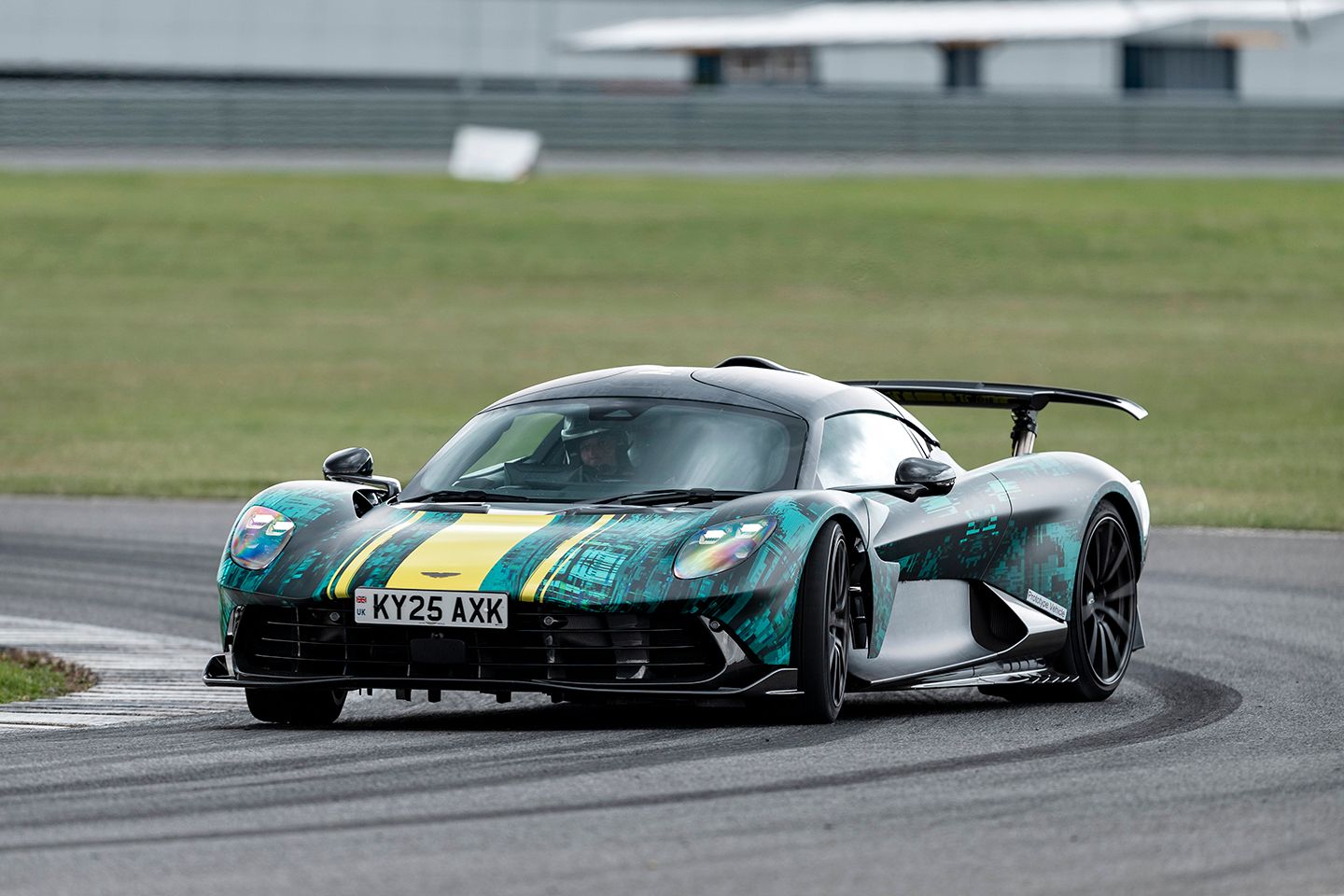
I’m not intimidated often by cars. Even the really powerful ones. But I don’t mind admitting that there was a frisson of fright rising through me at the thought of driving this prototype version of the Aston Martin Valhalla. I was driving it at Silverstone’s Stowe circuit, but that wasn’t causing the collywobbles; I know the circuit well. It wasn’t so much the ridiculousness of the car’s performance, either, which is, on paper, impressive. It was all just a bit rushed for my liking, having got the call late the day before as I stepped off a plane from holiday. And my head was still in holiday mode. I’d been drafted in as first reserve because Matt B had turned green the previous day. He couldn’t keep his food down while resting in bed, so driving a hypercar on track wasn’t exactly the panacea he needed. However, the main issue for me appeared when I opened the curtains on the morning of the drive and saw a strange liquid falling from the sky.
Eventually, I remembered that it’s a thing called rain, and, in drought-struck Britain, I wondered why it had decided to drop today of all days. The very day I was set to drive an £850k, mid-engined hypercar boasting nearly 1,100hp and 600kg of peak downforce. Forget the power and the downforce, though – it’s the price that bothered me. Anyone who gets behind the wheel of an £850k car and says they don’t feel pressure is either a liar or an idiot. Or maybe both. In this business, binning something that expensive guarantees infamy, and I’ve never wanted to be infamous. Still, I should’ve reminded myself of that quote by Mark Twain along the lines of: there’s been a lot of tragedy in my life, and some of it actually happened. Why? Well, by the time I arrived at Aston Martin’s Stowe Complex – Aston’s little enclave next to the circuit – the day had turned into a balmy one and the circuit was bone dry. Marvellous. Then they wheeled out the Valhalla, and the collywobbles returned. Boy oh boy, it’s an intimidating-looking thing. Especially in race-car-esque camo bodywork, with the rear wing extended like an ominous hackle on its back. It looked angry, albeit not quite as angry as the mighty Valkyrie.
This is an opportune time to point out that the Valhalla – other than being mid-engined and playing with the air that passes over and through it – has very little to do with the Valkyrie. This I learned during my walkaround with the car’s chief engineer, Andrew Kay. He began by saying something that should’ve been calming, but wasn’t. Actually, it left me thinking he was madder than the maddest frog in a crate of crackpot frogs. ‘The Valkyrie is more focused on the track,’ he said, ‘while we’ve designed the Valhalla to be more luxurious, more like a typical Aston Martin.’ I laughed immediately, but the nervous, involuntary kind. I mean, come on. At that very moment, the Valhalla’s vast gullwing doors were open like an eagle’s wings ready for launch – taking all but a sliver of the car’s roof with them – and exposing a cockpit that appeared to be as luxurious as a hermit’s cave. ‘That’s your idea of luxury?’ I said, before pointing out the enormous, exposed carbon-fibre sill and, what appeared to be, an impossibly narrow, spartan cockpit. Then I noticed the unforgiving-looking shell seats, which are heavily reclined with low hip points, and the footwell that rises in front of them, leading to the high-set pedals. Everything on show seemed skewed more towards LMP1 than Lagonda, but Kay was adamant. ‘The driving position’s not as extreme as the Valkyrie’s,’ he said, ‘and there’s more room inside. It’s got an infotainment screen, too, and reel-inertia seat belts.’ Well, whoopie do. Seat belts, aye? I stand corrected.
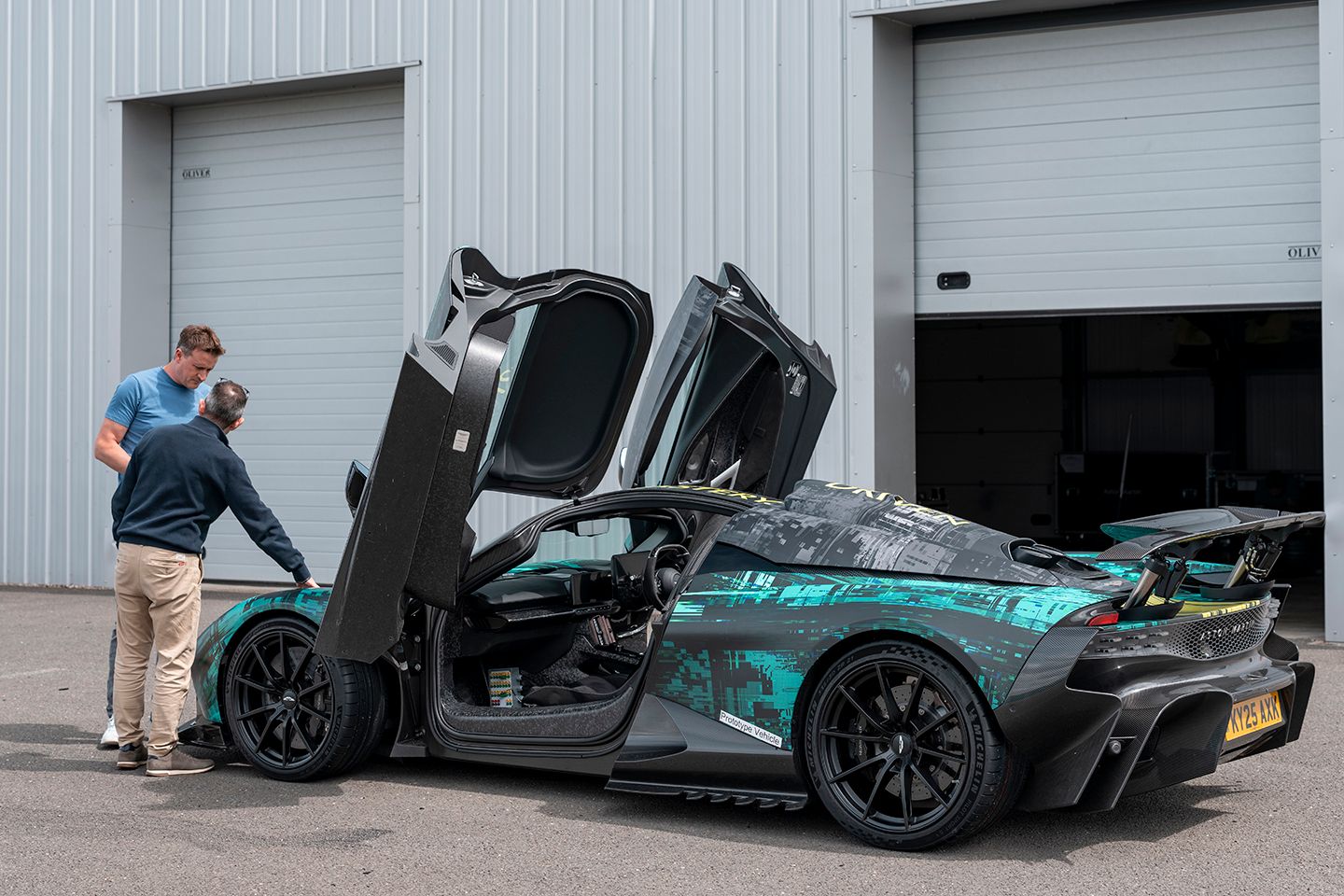
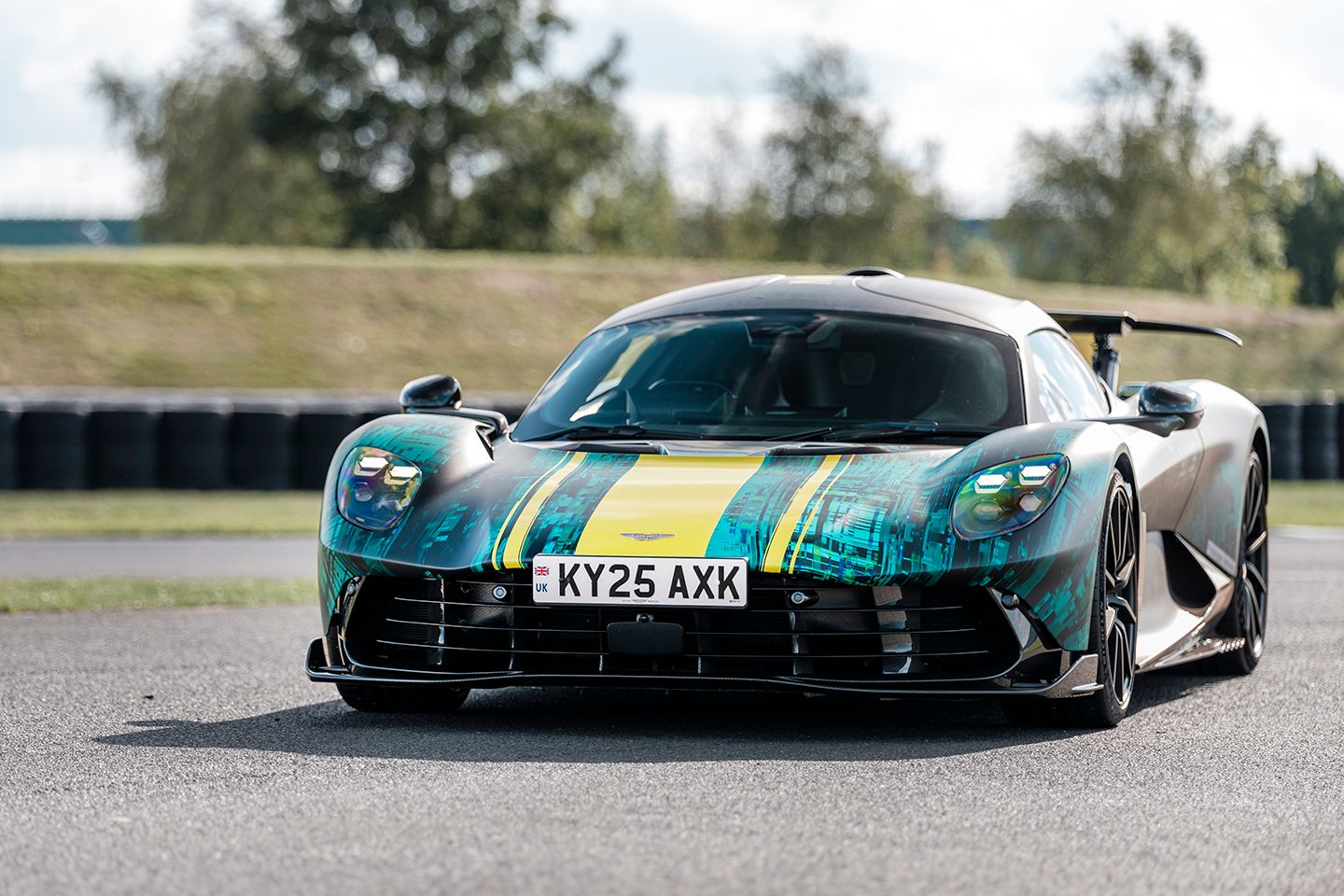
Then we focused on the exterior, which, as far as aero is concerned, is very focused indeed. No surprises there, considering the steady 600kg downforce this car generates between 149mph and its 217mph top speed. It uses hydraulically operated active aero front and rear to maintain that figure through the speed range, beginning with a movable, single wing spanning the width of the car. It’s just ahead of the front axle, if you’re wondering, but you can’t see it. It’s definitely there, however, adding downforce and keeping the split roughly 40:60 front to rear, except during hard braking. At the other end, the rear wing is very obvious and very acrobatic, too. Its range of movements includes a DRS setting, a downforce setting, and full-on air brake mode. Turning vanes behind the front wheels keep the air attached to the car’s scalloped doors, feeding the oil-cooling radiators in front of the rear wheels. I particularly love the turning vanes at the rear edge of the exposed floor. Very F1, I thought. There’s also a snorkel on the roof, foraging air for the engine’s air intakes and intercoolers, and providing cooling for the hot-vee turbochargers.
Speaking of the engine, it’s AMG’s 4.0-litre V8, but not the placid, cross-plane crank variety that Aston uses elsewhere. This one’s the angry, dry-sumped, flat-plane crank jobbie derived from the AMG GT Black Series. But it isn’t bolted into the Valhalla straight from the crate. Aston’s reworked the internals, including the pistons, cams and intake manifolds, and plumbed in some even bigger turbos that deliver up to 3 bar of boost. The V8 alone produces 828hp and 632 lb ft at a whisker under 7,000rpm, while the rest of the oomph – and we’re talking a total of 1,079hp and 811 lb ft – is added by the hybrid system’s three electric motors. One of these is on the all-new eight-speed dual-clutch gearbox. Its duties include mitigating turbo lag and making the car go backwards – there’s no reverse gear, to save weight. The other two motors are on the front axle providing four-wheel-drive traction when needed, but be in no doubt: the Valhalla’s torque split is biased heavily towards the rear wheels and tempered by an electronic rear differential. There are four exhausts in total. The periscope pipes poking out of the engine cover are the sole outlets on a light throttle – to get the Valhalla through the drive-by noise regs – while the main, freer-flowing exhausts emerge from within the aggressive rear diffuser. The standard exhaust system is stainless steel, while a lighter, titanium system is an option, saving around 2.5kg.
It’s obvious from the enormous black sills that the tub is carbon fibre. That was developed with input from the F1 team because they know the tricks of laying carbon weave to get the strength and lightness required. All the bodywork is carbon-fibre, too, but the subframes are aluminium. The front suspension is double wishbones with pushrod inboard dampers. That design was born out of necessity. It allowed the team to get the front of the car low enough for the driver to see out – an attribute that’s always handy, I find. And you can see the horizontal springs through the holes left in the bodywork; they’re exposed for no other reason than they look snazzy. The rear suspension is a five-link arrangement, and the Valhalla uses Bilstein DTX adaptive dampers all round. Last but not least, the bushing is rubber rather than rose jointed. After all, it’s a luxurious road car, right? Complete with a hydraulic nose lift to get you up and over speed bumps on the King’s Road.
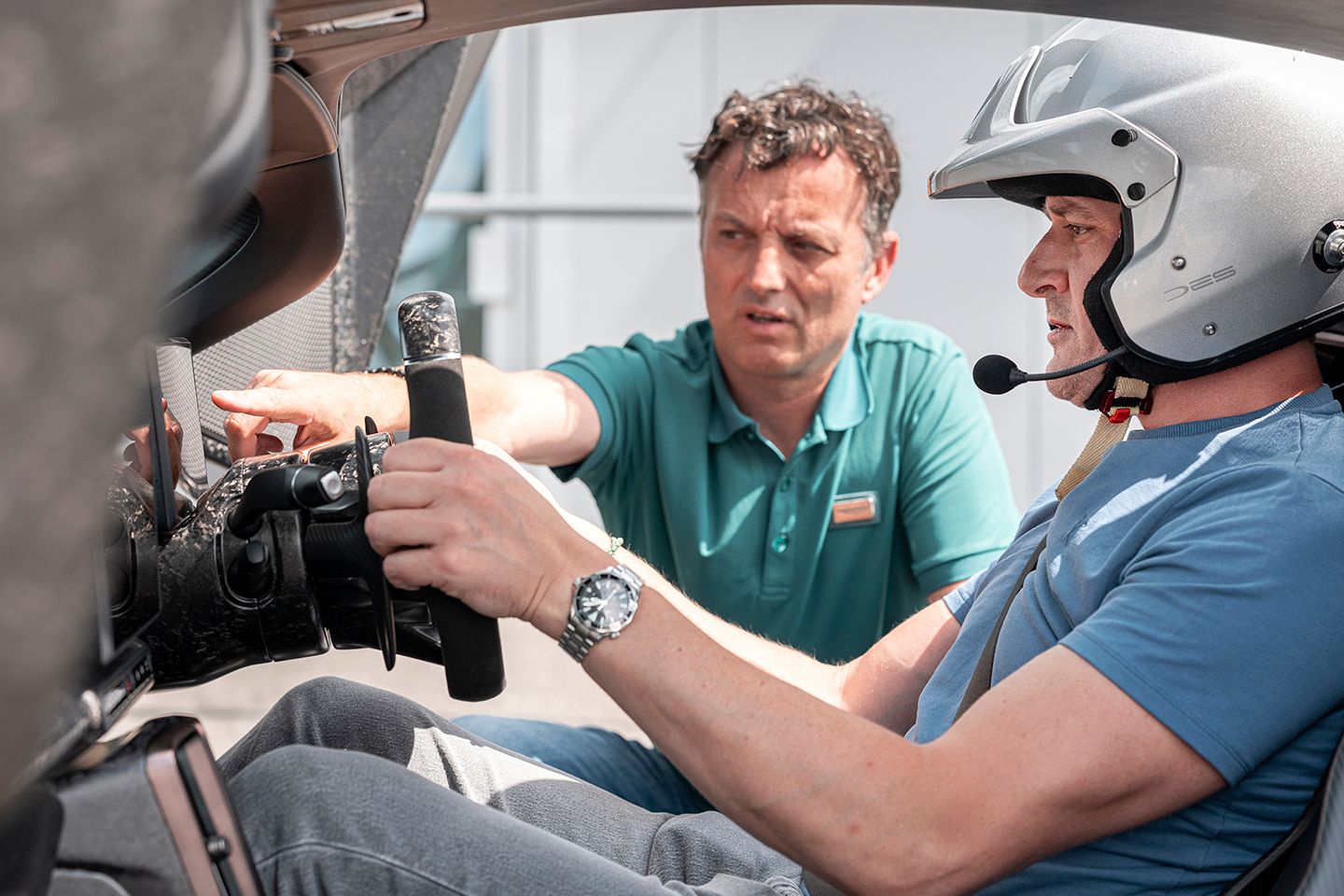
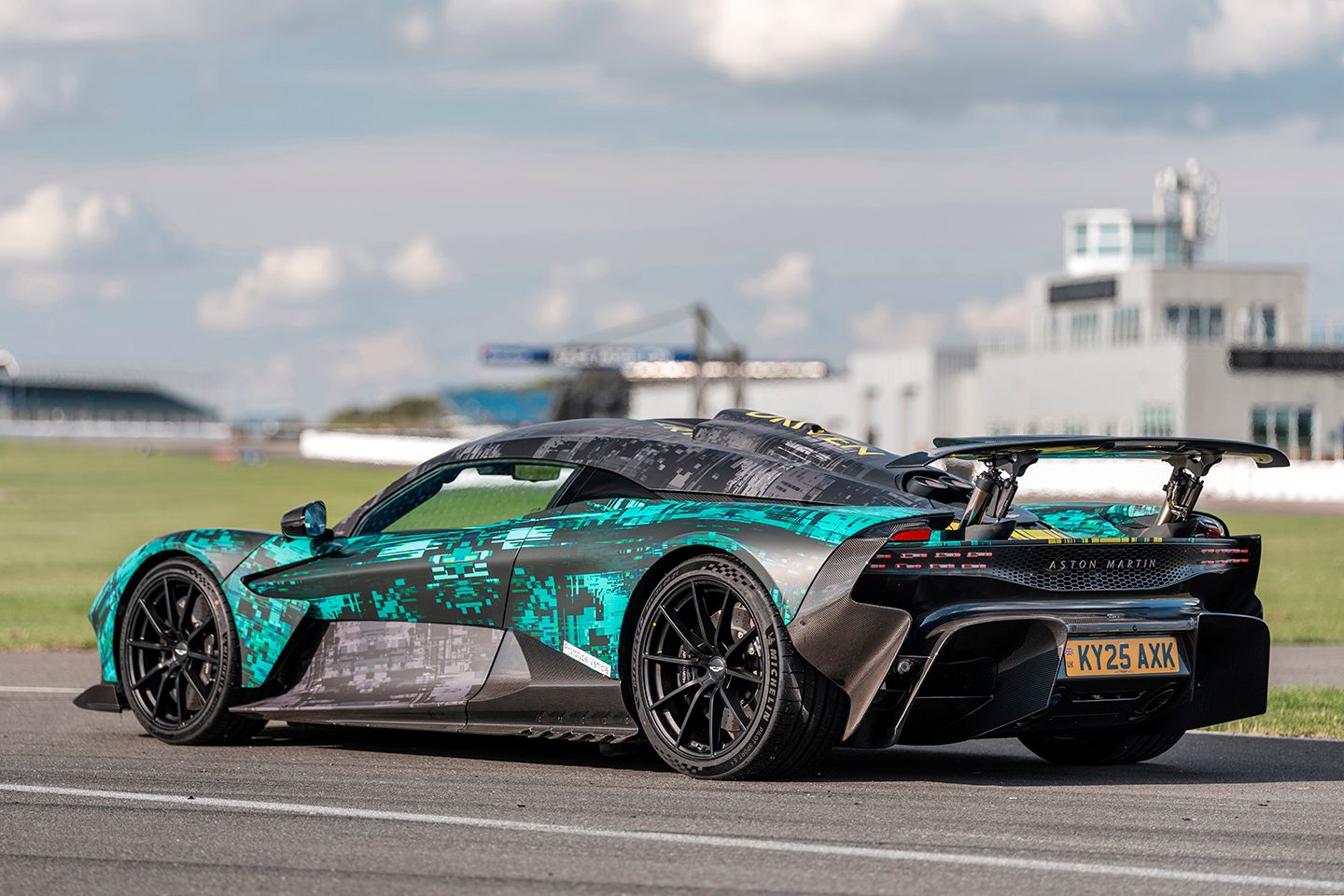
Just look at it, though. A road car…really? Nah, this is a track car first and foremost, just one that can be used on the road, which is the very opposite of the Lamborghini Temerario that I drove last month. That was more of a road car that can be used on track. So, is the Valhalla half a million pounds better than the Temerario on track? That would be a tall order, but it looks up for the challenge. I knew it was going to be a bit tasty when the team sent me out on track in a Vantage for some sighting laps. Yep, a ‘training’ car with more than 650hp to get me warmed up. That sounds silly, until you think that 650hp isn’t that far off half the Valhalla’s potential. A few laps later, I was suitably dialled into the Vantage, so it was time for the main event, although my first taste of the Valhalla wasn’t from behind the wheel. It was sitting next to Aston’s development driver, Darren Turner, who seemed very keen to show me how to turn down the traction control. I looked at him like he was mad, too. It’s got 1,100hp, for heaven’s sake. Then it was my turn, and I was told to go out on my own and have fun. Yeah, right, I thought: it’s got 1,100hp. But, the thing is, the Valhalla turned out to be very good fun indeed.
For a start, the driving position is spot on. I mentioned earlier that the cockpit looked very LMP1 while I was staring at it from outside, and it feels more so from within – in a good way. It may not be as extreme as the Valkyrie’s, but it is still jolly narrow and you’re hugged intently by the shell seat. Yet, despite the lack of plushness, it’s extremely comfortable. I felt plugged in, like the last component – the code key, if you like – needed to activate some kind of demonic device. The reclined seat and legs-up stance work superbly well, and, combined with the small, square steering wheel that extended right to my chest, I felt totally at home. I fitted, too, despite my gangliness – the double-bubble roof providing enough headroom even with a lid on. And I could see out easily, with the view out over the low front adding to the racing-car sense of occasion. Nothing for it, then, but to snick first gear and get the laps underway.
I didn’t bother with all the driving modes. Sure, I was still apprehensive, but I was hardly going to use EV mode: it makes the Valhalla front-wheel drive and limits the top speed to 80mph. That’s too tame even for me. In fact, I started in Race mode. Weirdly, that gives you slightly less power than the Sport + mode, which is one click back on the rotary selector. That’s all to do with battery management. Race mode gives consistent performance without the battery dying after a few laps. Sport +, on the other hand, is more like a qualifying mode – or, this being a Mercedes-AMG-powered car, a party mode, perhaps. That said, I was told that, on a short track like Stowe, battery condition wouldn’t be a problem; nevertheless, I thought a little less power was a good way to build up some confidence. It turns out it’s still flipping quick, though. The Valhalla absolutely romps down Stowe’s back straight, with the quick-but-semi-brutal gearshifts and the hard-edged timbre of the flat-plane-crank motor adding to the theatre. Is it soulful? Well, I was wearing a lid, so it’s hard to say for certain, but I’d say soulful is pushing it. Purposeful is a better adjective. And with the limiter set relatively low (for a hypercar) it’s not as thrilling as a Temerario screaming away to its 10,000rpm crescendo. There’s nothing underwhelming about the power delivery, though. The way the powertrain picks up is sublime – like your right foot’s hardwired to the crankshaft – and it’s oh-so tractable. The only issue I had was the engine revs so freely to its meagre maximum that I kept banging into the limiter.
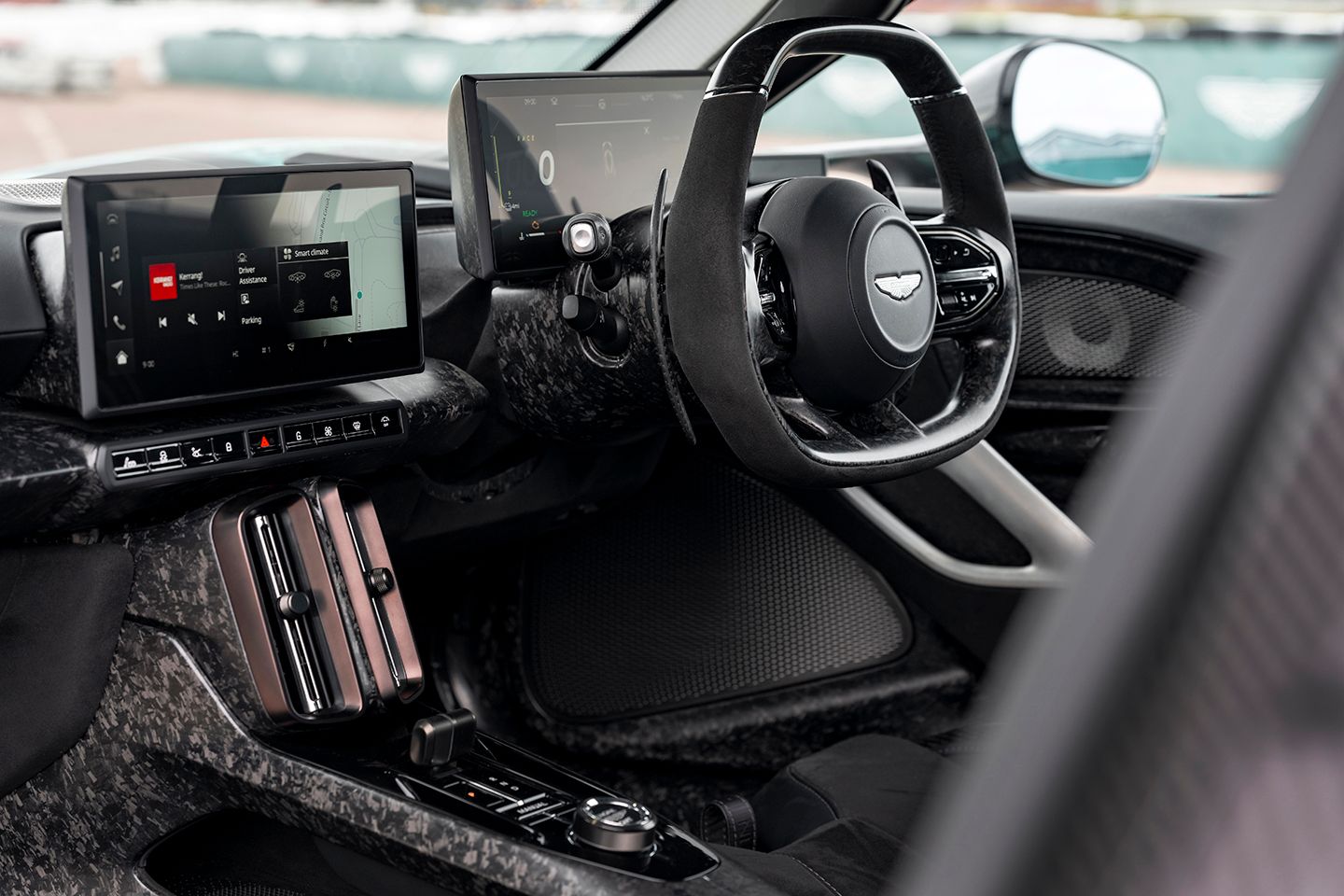
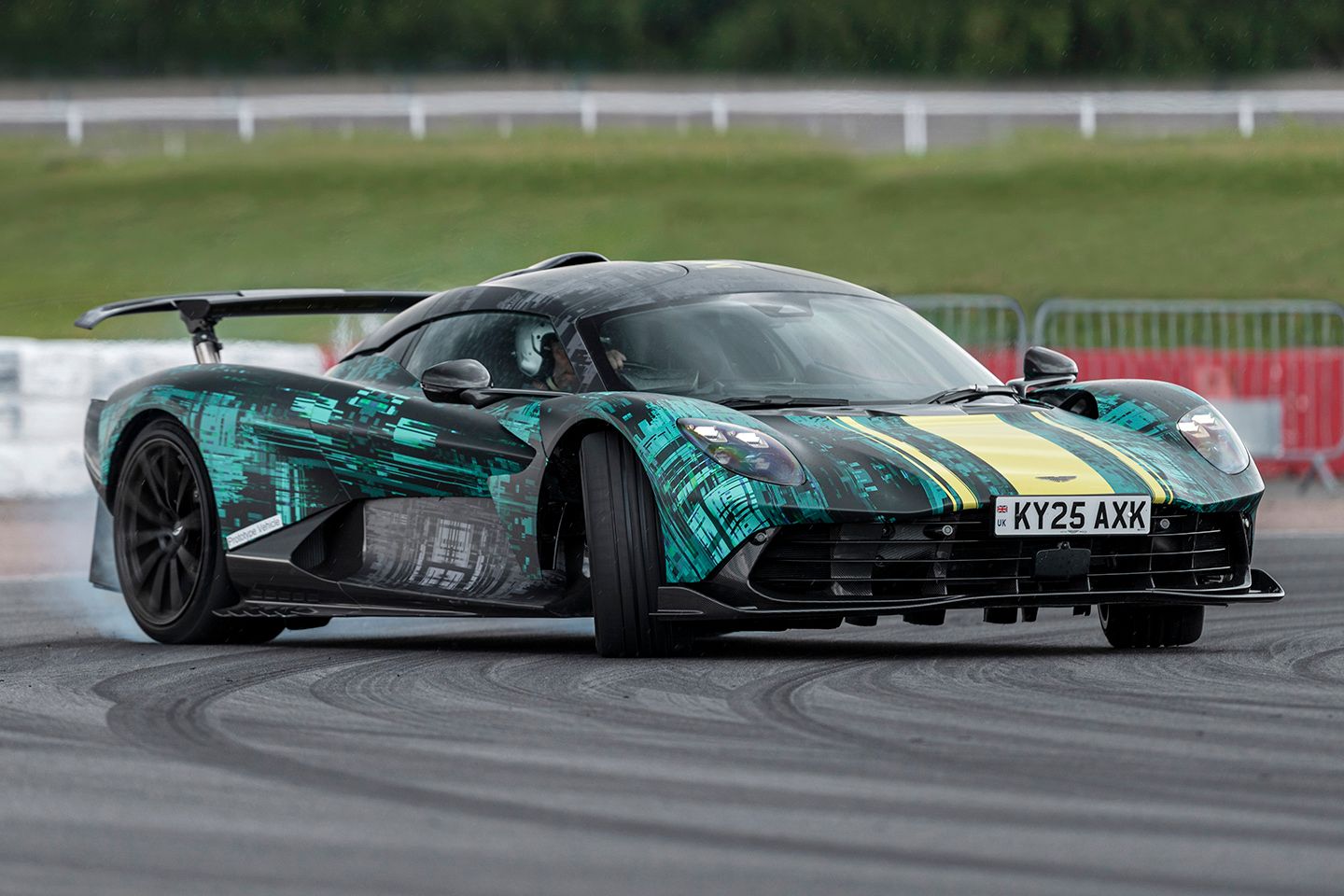
In my defence, the shift lights, which will appear on the production models, weren’t working on this prototype. Well, that’s my excuse. And here’s my next one: I was feathering the throttle in the fast kink leading onto the pit straight because, well, I couldn’t believe the Valhalla had the grip or traction to take it at full beans. My brain simply couldn’t compute it had enough of either to deal with the sideways forces acting on my body as I rounded the turn while the speed was building so incomprehensibly. Somehow, I needed to recalibrate, and not just to the straight-line performance or the cornering speeds: to everything. The brakes, for example. The pedal feels a little soft for a car of this magnitude, but the magnitude of the stopping power isn’t in question. Those Brembo carbon ceramics bite, I tell you, so ferociously that I was braking way too early. And then there’s the Valhalla’s zest on corner entry. The steering response is calm and friendly just off the straight ahead, yet, as you add on a few more degrees of lock, it feels like it quickens as the Valhalla is suddenly sucking up the apex. Can I be honest with you? All this immediacy – the speed, grip, braking – conspired to make my first three laps somewhat disjointed. So I gave my head a wobble, and, over the next three laps, things started to flow. And do you know what? I started to feel at ease. Relaxed, even. So much so that I was beginning to push by lap six, but that’s when they called me in to check the tyre pressures. Still, that was a useful time to ruminate and digest before my next go.
A few minutes later, I was trundling down the pitlane again when a thought struck me: the Valhalla rides well, considering the rough, patchwork surface I was trundling over. My second thought was that I should pop it into Sport +. I mean, seriously, I had to sample the full-fat mode, right? And the ramp-up in performance is unmistakable as I fired towards the first turn. That said, I had this nagging sense that the Valhalla doesn’t feel as quick as the less powerful Temerario. I’m far from certain about that, however, bearing in mind this wasn’t a back-to-back test. I’ll say this, though: when I glanced down at the speedo towards the end of the relatively short back straight, I’m pretty sure I saw 150mph and my foot remained pinned as I looked up to pick my braking point. Who knows what the final tally was, but that’s a big number for such a short squirt. Was I feeling intimidated by it? Nervous? No, not a bit. Sure, some higher-speed corners – where I’d have to really trust the downforce – might’ve tested my mettle more, but around Stowe’s slow to medium speed bends, the Valhalla was a hoot.
Now I’d dialled in to the turn-in and grip, I recognised that the steering is fluent and accurate. A little more feel, as the front end approaches the limit of grip, would be nice, but that’s something I’m particularly sensitive to. And I trusted that carrying a few too many mph into a corner wasn’t going to be disastrous. When it understeers, the Valhalla doesn’t schlep towards the outside of the turns like the surface is strewn with banana skins. As the grip fades, it transitions gently. You have only to lift off the throttle – or, at worst, caress the brake pedal – and it rotates beautifully back on line. In that phase, I also had full confidence that the rear wouldn’t bite me, either. I should point out that, for some strange reason, this prototype wasn’t fitted with Michelin Cup 2 tyres. It was on more road-biased Pilot Sport 5s, which, with bigger tread blocks, will always allow more movement. I fully expect that the precision of the Cup 2 tyre would foster even more confidence.
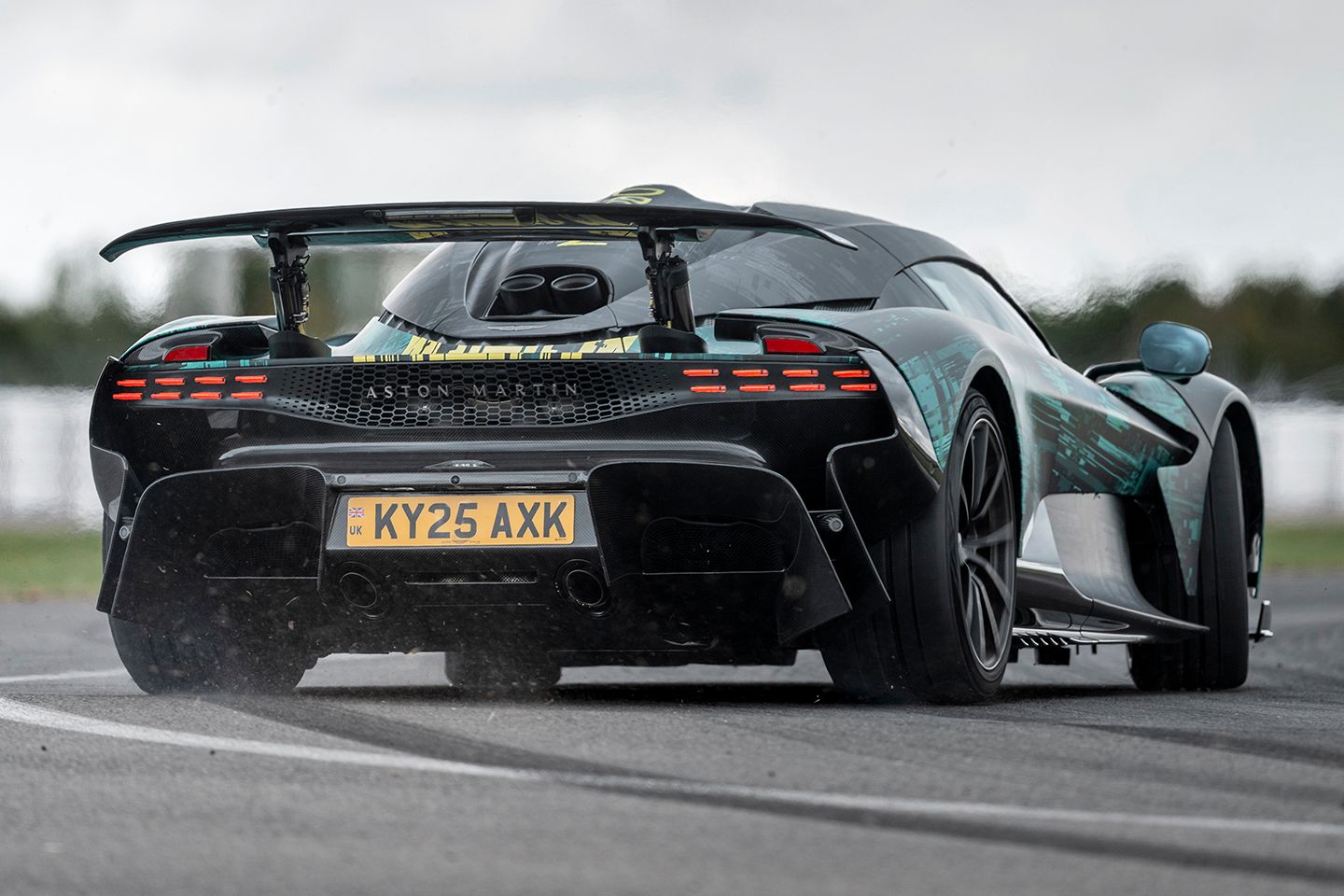
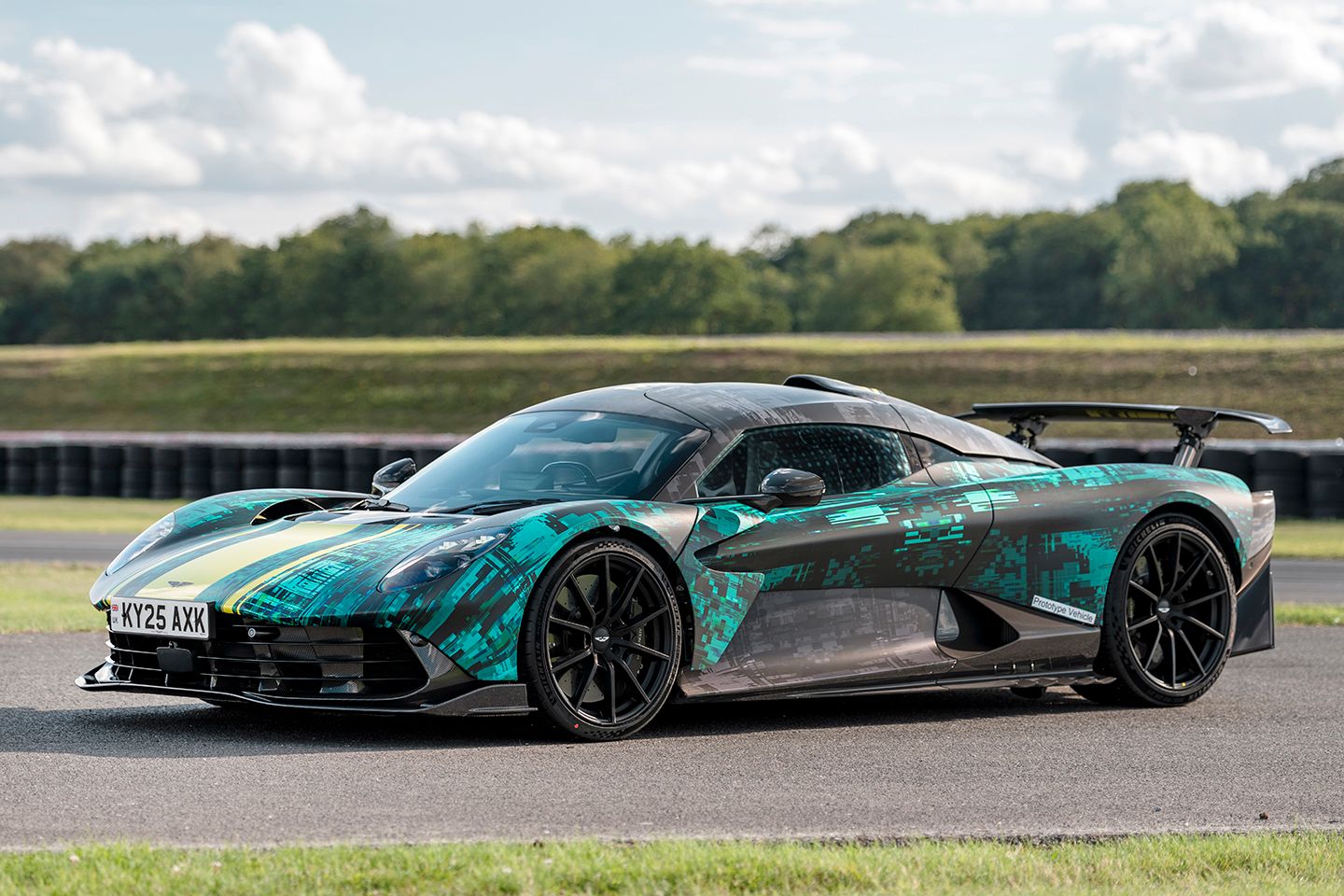
By now, I was so at ease I did the unthinkable: dialled down the variable traction control several clicks. I couldn’t help myself if I’m honest, and I’m jolly glad I did. I realised I could trust the rear implicitly under power as well. Why? Because you feel every slide building through the chassis, the seat and, ultimately, your backside. You know it’s coming from the very slightest twitch. And because it’s not a surprise – you’re sensing the slide rather than seeing it – you can deal with it sooner. I ended up playing with the traction out of corners without worrying my destiny was the Armco and many apologies. That intuitiveness is key. It’s the mark of a truly great car for me, and one that’s rare outside of something bred for racing.
It’s a great feeling to go from apprehension to admiration in a dozen laps. To feel at one with a car is, for me at least, one of the greatest joys in life. And by the end of my time with the Valhalla, I felt truly at one with it. When I got back to the pits, Turner came to ask what I thought. I couldn’t help smiling as I said, ‘It’s remarkable.’ And it is, but I was still a little confused. I’m not one of those blowhards who says something dumb like: if a car doesn’t want to kill you, it’s not exciting. That’s absolute rubbish. Nevertheless, there was this part of my brain wondering whether an £850k car, with more wings than Red Bull, and more than twice the horsepower of a Ferrari F40, should feel this docile? That’s what the Valhalla is: docile. However, the Valhalla isn’t vanilla. It’s just a beautifully balanced, communicative and very drivable car on track. My overriding thought was that it’s basically a big go-kart, which is the ultimate compliment. Go-karts are always fun, and to make one with 1,100hp feel so approachable after so few laps is, I believe, impressive.
I hope the fun element comes across to you in this review because that’s the true barometer of a car’s worth. Not money, as such, and all the power and downforce in the world mean nothing if something isn’t fun. Still, I have to say whether it’s objectively worth £850k, or half-a-mill more than a Temerario. So, is it? No, of course not. But only because I don’t think any car is worth £850k, truth be told. If price wasn’t an issue, mind, would I die for an empty track and a Valhalla to go chipping away at my lap times ‘til sunset? You bet I would. Have you ever read a phrase that goes something like this in a car review: it is the best Aston Martin I’ve ever driven? Let me tell you what that means as a rule. Usually, it’s written by someone who wishes that the latest Aston was good, but, relative to everything else, it’s a pile of crap. Yet the Valhalla is the best Aston Martin I’ve ever driven, and I say that with my tongue firmly outside my cheek. And speaking of cheeks: MB, if you’re reading this, I hope yours aren’t green anymore. I’ll wager that right now you’re feeling green with envy, though – and so you should be my friend.
SPECIFICATION | 2025 ASTON MARTIN VALHALLA
Engine: 3,982cc V8, twin-turbo, plus three axial-flux motors
Transmission: 8-speed dual-clutch auto, all-wheel drive
Power (hp): 828 @ 6,700rpm (1,079hp total)
Torque (lb ft): 632 @ 6,700rpm (811 total)
0-62mph: 2.5 seconds
Top speed: 217mph
Weight: 1,655kg (dry)
CO2: TBC
MPG: TBC
Price: £850,000

